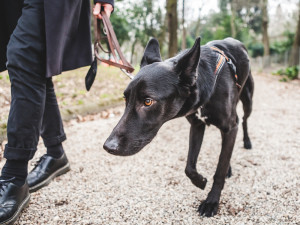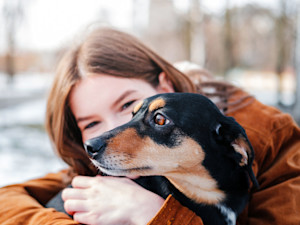Why Does Your Dog Go Between Your Legs?
From affection to anxiety, how to understand this clingy behavior.

Share Article
In This Article:
Why Dogs Go Between Legs The Most Common Reasons Dogs Go Between Legs Should You Allow Your Dog to Do This? How to Address and Modify This Behavior How to Improve Your Dog’s Confidence When to Seek Professional Help
Sometimes you might look down as you’re standing, and there is your pup, hanging out right between your legs. There are many reasons why your canine friend likes to stand between your legs, sit between your legs, or even sit on your feet. Aside from being cute, your dog may be showing you affection, feeling anxious, or looking for attention.
And if it’s starting to become a bit much — don’t worry, that doesn’t make you a bad pet parent — it’s a behavior that you can modify, too. Let’s walk through those steps.
Main takeaways
Dogs go between legs for many different reasons, ranging from affection to anxiety.
Improving your dog’s confidence might be something that could help curb this behavior.
You can also use other training methods such as positive reinforcement or a cone to stop your dog from going in between your legs.
If it becomes an annoyance, a safety risk, or your dog is showing signs of anxiety or fear, then it might be time to call a professional.
Understanding dog behavior: Why they go between legs
According to dog trainer Shir Limatazi, who owns Another Chance Trainingopens in new tab, there’s a lot to keep in mind when your dog behaves this way. “There are many reasons why your dog may go between your legs. Some dogs go between your legs to show affection towards you,” she says. “And some dogs go between your legs because they are scared and need your reassurance. The best way to know why your dog is going between your legs is to consider the context, and pay attention to their body language.”
How much do you spend on your pet per year?

The most common reasons dogs go between legs
The reasons why dogs go between legs can range from looking for attention to seeking warmth. Here are the most common explanations for this behavior.
1. Seeking comfort and security
Dogs like to be close to those who comfort them. So if your dog goes in between your legs, it might just be because they are looking for comfort from their favorite person.
2. Submissive behavior
Your dog might be showing you that they are submissive by going in between your legs. However, the submissive behavior might also stem from your pup being scared or anxious (see “Experiencing anxiety or fear,” below).
3. Looking for attention or affection
Your dog could just be looking for attention or affection from you when it goes between your legs. “If you just came home from work and your dog is running towards you tail wagging, ears perked, and they go between your legs — this clearly means they are happy to see you and showing you some love,” Limazati says.
4. Experiencing anxiety or fear
This behavior may also be associated with anxiety or fear, which is another reason to read your dog’s body language. Other indicators include a lowered tail, whining, pacing, or excessive barking. Limazati explains, “If you are outside and a garbage truck is making loud noises, and your dog goes between your legs with their tail tucked and head down, this most likely means they are scared.”
5. Feeling cold or seeking warmth
If you are outside with your dog in cold weather, this could also be a sign that your dog is cold and coming to you for warmth. If they are shivering or in a hunched posture, those are other indicators that they may be cold.
Should you allow your dog to go between your legs?
If this behavior isn’t bothersome, you don’t need to do anything. In fact, this can even help tighten your relationship with your dog. “As a trainer, I teach dogs the middle cue to go through their pet parent’s legs on cue for many reasons and uses,” Limazati says. “Going through legs can build a bond between a pet parent and dog, can build confidence, and can also keep a dog safe, for example, in a crowded space like an elevator.”
However, depending on the way your dog uses this behavior, you may want to consider training to curb it.
How to address and modify your dog’s behavior
“If your dog is constantly going in between your legs because they are afraid of people, places, or things, this is a sign that it’s time to bring in a professional, certified behavioral trainer to help your dog gain confidence and independence,” Limazati says. “Sometimes, a dog can be protective of their pet parent and guard them from in between their legs. This, too, is a reason to bring in professional help. You never want to let anyone pet your dog while they are between your legs, as your dog may feel protective or threatened in that position.”
Pay attention to your dog when they are in between your legs, and consider why they might be participating in that behavior — and if it’s something worth modifying. Here are some ways you may begin to change that behavior.
Use positive reinforcement techniques
Using positive reinforcement techniques involves petting your dog, praising them, and giving them treats when your pup is in a preferred position that isn’t between your legs.
Stop giving them attention when they do it
Ignoring your dog when they try this behavior is a good way to begin to correct it. You can also begin making the space between your legs inaccessible so they can’t get in there, learning that it isn’t an acceptable place for them to stand or sit.
How to improve your dog’s confidence
Positive reinforcement for good behaviors is a great way to boost your dog’s confidence. Consistent training and lots of physical activity can help, as does creating a safe space for your pup and providing lots of patience as a pet parent. One of the most important things you can do is take the time to observe your dog’s body language, so you can understand how to better help them.
When to seek professional help
If your dog standing or sitting between your legs is coupled with anxiety, fear, or aggression, it might be time to seek a professional trainer. Also, if it’s becoming a daily annoyance or causing a safety risk, be sure to contact your veterinarian.

Kerensa Cadenas
Kerensa Cadenas is a writer based in New York City. She’s previously worked at The Cut, Thrillist, Cosmopolitan, and Complex. Her work has been featured in Vulture, GQ, Vanity Fair, and others.
Related articles
![A shy looking dog sitting on a couch.]()
Some Dogs Are Scaredy Cats — And That’s OK
Not all fearful dogs have been mistreated.
![Puppy hides under the couch in fear]()
How to Keep Your Dog From Freaking Out When You Have Company
Do these things to help your pup (and your guests) feel chill.
![Woman holding her scared dog outside.]()
5 Surprising Things That Dogs Are Afraid Of
And what to do when they go careening away from the Roomba.





